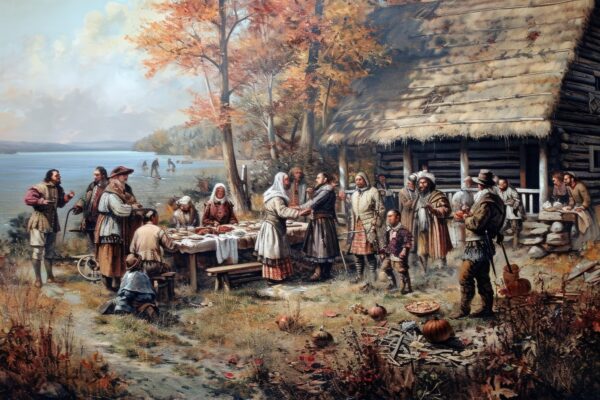Thanksgiving is widely celebrated today as a day for gathering with family and friends, enjoying a feast, and reflecting on gratitude. Jeff Derderian highlights the origins of Thanksgiving look quite different from the modern holiday, both in terms of what was eaten and how it was celebrated.
Thanksgiving: 1621
The first Thanksgiving is commonly attributed to a harvest celebration held in the autumn of 1621. The event took place at the Plymouth Colony in present-day Massachusetts. The Pilgrims, a group of English Puritans who had settled in Plymouth after a challenging first winter, organized the event as a three-day feast. They invited members of the local Wampanoag tribe, including their leader, Chief Massasoit. It’s estimated that around 50 Pilgrims and 90 Wampanoag people were present.
The Wampanoag had helped the Pilgrims survive by teaching them essential agricultural practices, and the feast marked a celebration of the year’s harvest—a critical accomplishment after the Pilgrims’ difficult journey and harsh conditions the previous winter.
The First Thanksgiving Meal
The menu of the first Thanksgiving was significantly different from what we enjoy today. Instead of turkey, cranberry sauce, and pumpkin pie, the meal was likely centered around items that were abundant in the area and familiar to both the Pilgrims and the Wampanoag. Historical records suggest that the feast included waterfowl (such as ducks and geese), venison, and seafood like fish and shellfish. Corn was present but not as the sweet corn we know today; instead, it was in the form of cornmeal used for porridge or bread. Wild berries, nuts, and native squash were also likely part of the meal. There were no pies or sweet desserts, as the Pilgrims lacked both sugar and ovens
The cooking methods were basic, relying on boiling, roasting, and baking in makeshift outdoor ovens. Traditional spices and sweeteners were largely absent. The Wampanoag likely contributed to the feast by sharing foods and ingredients that were unfamiliar to the Pilgrims, such as native plants, nuts, and herbs
How Thanksgiving Evolved
Thanksgiving was not immediately established as an annual tradition. In fact, similar feasts were held sporadically to celebrate good harvests, military victories, or other occasions of thanksgiving across the early colonies. It wasn’t until 1789 that President George Washington declared a national Thanksgiving holiday, though it was celebrated irregularly. In 1863, amid the Civil War, President Abraham Lincoln proclaimed Thanksgiving a national holiday to be held each November, hoping to unify the nation. From there, the holiday became an annual event, and traditions slowly evolved.
The Modern Thanksgiving Meal
Today’s Thanksgiving meal has transformed considerably since the 1621 feast. The centerpiece of most Thanksgiving tables is roast turkey, which became associated with the holiday partly because it is native to North America and can feed a large group. Cranberry sauce, mashed potatoes, stuffing, and pumpkin pie—iconic Thanksgiving dishes—were introduced over the years as ingredients like sugar and flour became more accessible. These dishes reflect both regional tastes and cultural influences that have melded over centuries
Cranberries, for instance, were familiar to Native Americans and Pilgrims but weren’t made into the sweet sauce we know until much later. Pumpkin pie also evolved as new varieties of pumpkins and squash were cultivated and baking technology improved. These changes reflect how the Thanksgiving meal evolved alongside agricultural and culinary developments.
How Thanksgiving Traditions Have Changed
Thanksgiving today is more than just the meal; it includes traditions like the Macy’s Thanksgiving Day Parade, which began in 1924 and is now watched by millions each year. The tradition of watching football games on Thanksgiving started in the late 19th century with college games and became part of the NFL schedule in 1934.
Additionally, the holiday has become a time for charitable activities and community gatherings, with many people volunteering at shelters or participating in “Friendsgiving,” a variation that involves celebrating Thanksgiving with friends. In recent years, discussions about the holiday’s history and its impact on Native Americans have also become more prominent, adding another layer of reflection.
Thanksgiving Today: A Mix of Traditions
Thanksgiving is now a blend of historical homage and modern family customs. Although it has come a long way from the first feast in 1621, the central themes of gratitude, sharing, and community remain intact. The holiday reflects both the cultural diversity of the United States and the values that have shaped the country. While the Pilgrims’ meal with the Wampanoag may look vastly different from what we enjoy today, Thanksgiving continues to be a meaningful occasion for millions of people across the country.
